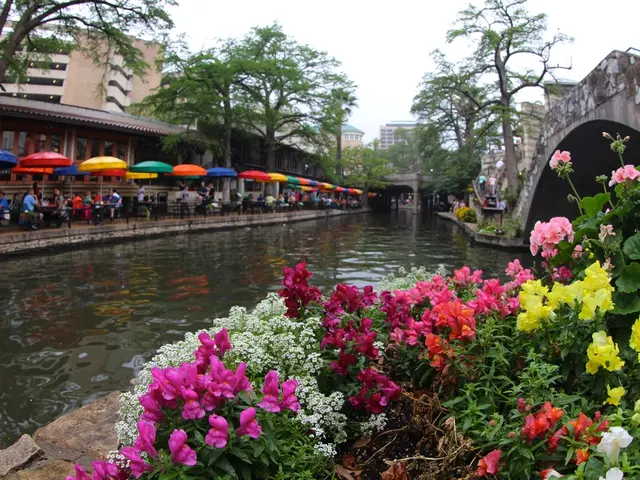Amount of Water to Carry for a Hiking Expedition
Navigate the thrilling world of hiking with an informed approach to water consumption. Hydration is the lifeblood of your outdoor adventure, keeping you strong and focused as you traverse nature's majestic trails. But figuring out how much H2O to bring along can be challenging, given the myriad factors affecting your hydration needs. Let's demystify this essential component of your hiking prep, so you can conquer any mountain with confidence.
Drinking water while hiking: the ultimate guide
The quest for the optimal water intake during a hike is a complex puzzle. Temperature, exercise intensity, and individual body characteristics all play a significant role. To ensure you're well-equipped to chase adventure with affected vigor, read on as we break down the secrets of staying hydrated in different weather conditions.
How much water should I drink while hiking?
Standard guidelines:
As a starting point, aim to drink about 1 liter (32 ounces) of water every 2 hours of moderate activity in moderate temperatures. This may fluctuate depending on various factors such as weather, trail difficulty, and personal needs. However, this rule of thumb supplies a solid foundation for estimating your hydration requirements.
The heat is on:
In hot weather, thunderous conditions may require a significant increase in water consumption. Sweat pours out, and your body could lose up to a liter or more of water per hour[1]. Adjust your water intake accordingly to avoid dehydration, and consider packing water filtration devices to restock your supply along the way during epic multi-day adventures.
Refrigerate the chill:
Cold temps may not seem like a hydration hotbed, but your body still requires water. Wearing multiple layers and increased metabolic demands can surprisingly intensify your water needs. Aim to maintain the same regimen as moderate conditions. Keep in mind that water sources may freeze, so insulated water bottles could be a handy addition to your hiking arsenal.
Factors affecting water intake:
Temperature
Hot and humid weather pushes our bodies to produce more sweat, elevating our hydration requirements. Conversely, colder climes might not have you drenched in perspiration, but energy expenditure can rise, leading to increased water consumption.
Activity intensity & duration
Longer, harder hiking journeys = more water needed. Uphill battles or hefty packs can intensify your body's water needs.
Altitude
Higher ground lends to increased respiration, resulting in a greater thirst[5].
Individual physiology
We come in all shapes and sizes, and our hydration needs reflect this diversity. Age, sex, weight, and overall health are essential factors in determining your personal hydration needs.
Acclimatization
Internalize the environment you're hiking in, and you might boast a better ability to manage water loss[2].
Diet
High-water-content foods like fresh fruits and vegetables can alleviate some water needs, while salty or dehydrated meals may enhance your thirst.
Hydration in different weather conditions:
Regardless of the weather, proper hydration is essential during a hike. Customize your water intake according to the conditions you face on the trail:
Hot weather:
In sun-soaked conditions, aim to consume about half a liter to one liter more per hour compared to moderate conditions, since excessive perspiration can lead to dehydration[1]. Additionally, don't forget to replenish electrolytes as you go to optimize your water intake efficiency[3].
Cold weather:
Keep hydrated in chilly conditions as you would in more moderate ones. Regardless of the common belief, hiking in cold weather increases water needs. Air may be drier, which can accelerate water loss[2][3], and your body might work harder maintaining its temperature, elevating water demand. It's essential to take precautions to prevent water freezing, too[2].
The importance of proper hydration:
Hydration is the cornerstone of a gratifying and safe hiking outing. It fuels your body, ensuring your muscles, heart, and organs operate optimally. Maintaining proper hydration helps your body regulate temperature, keeps your energy sustained, and can even boost your cognitive abilities[2]. Conversely, dehydration can cause dizziness, confusion, and impaired judgment — all of which can be hazardous in the wilderness[2].
But hydration's benefits extend beyond physical nourishment. Enjoying the great outdoors to its fullest involves feeling comfortable, free from discomforts like thirst, fatigue, or heat exhaustion[3]. So understanding how much water to bring on a hike, as well as maintaining good hydration habits, is critical for your hiking success.
Planning your water supply:
Anticipate your water needs and plan accordingly before setting off on your hike:
- Estimate the duration & pace: Calculate the total distance of your hike and estimate the time it will take based on your average speed to estimate your hydration needs[4].
- Adjust for weather: Climate and exercise intensity affect hydration requirements, so tailor your water supply to suit the conditions.
- Consider personal needs: Factor in any individual preferences, like consuming more or less water than average folks[2].
- Plan for refills: If your hike includes reliable water sources like streams or lakes, plan your refill points. Bring a water filter or purifier to ensure water safety[1].
Tools for carrying water on the trail:
Hydration packs, water bottles, and collapsible containers each have their advantages and limitations:
Hydration packs
The convenience of hydration packs comes with the challenge of monitoring water levels. Consumer preference for 3-liter packs on longer day hikes. Frequent cleaning is crucial to maintain a clean water supply[1].
Water bottles
Water bottles allow for more straightforward monitoring of water levels. Pick BPA-free, leak-proof bottles suitable for hiking[1].
Collapsible containers
Compact and lightweight, collapsible water containers are ideal for minimizing bulk. Many incorporate built-in filtration systems, which can be advantageous when filtering water on the trail[1].
Staying hydrated on the trail:
Stay hydrated during your hike with these useful tips:
- Pre-hike hydration: Drink half a liter of water before starting your hike to ensure your body is stocked with essential fluids[1].
- Sip regularly: Drink small amounts every 20-30 minutes to prevent dehydration[4].
- Monitor Body's signals: Keep a keen eye on signs of dehydration like dark urine, headaches, or fatigue, and adjust your water intake accordingly[2].
- Optimize gear: Wear breathable, moisture-wicking clothing to minimize sweat and maintain hydration levels[1].
- Replenish electrolytes: Consider carrying electrolyte replacement products, like drinks, tablets, or gels, to enhance your hydration efficiency[3].
Refilling water sources:
If you need to refill your water supply during a hike, follow these suggestions:
- Scout out reliable water sources: Check maps and guides for stream or lake locations along your trail.
- Filter or purify water: Utilize a filter, purifier, or chemical treatment to sterilize water and prevent contamination[1].
- Plan refill points: Estimate the distance between refill spots and adjust your water supply accordingly[4].
Dehydration: symptoms, treatment, and prevention
Dehydration symptoms:
Dehydration can manifest itself in several ways, including:
- Headaches, lightheadedness, and fatigue
- Feel thirsty
- Dark and strong-smelling urine
- Irritability
- Disorientation
- Poor coordination
- Difficulty speaking or slurred speech
Dehydration can be hazardous in the wilderness, and severe cases can lead to life-threatening conditions like heatstroke[2].
Prevent dehydration:
- Start hydrated: Drink plenty of water before setting off on your hike, hydrating your system to begin with[2].
- Take breaks: Pause for a few minutes every hour to rehydrate[4].
- Monitor symptoms: Pay attention to signs of dehydration and respond accordingly[2].
Treat dehydration on the trail:
- Find shade and rest[2].
- Rehydrate with water, electrolytes, or sports drinks[2].
- Cool down by soaking clothing or a hat in water[2].
- Resume hiking only after symptoms have subsided or seek help if they don't subside.
Final thoughts
Embarking on a hiking expedition is an exhilarating way to explore the great outdoors and test your physical limits. But proper hydration is vital to ensure a safe, enjoyable experience. Understanding your body's water requirements, accounting for different factors, and adapting based on the environmental conditions will empower you to conquer any trail with confidence. So pack that water, embrace the wilderness, and let the beauty of nature sustain your journey!
- Drinking the right amount of water while hiking can be complex due to factors like temperature, exercise intensity, and individual body characteristics.
- In hot weather, it's essential to increase water consumption as sweat production can lead to dehydration. It's also beneficial to replenish electrolytes.
- Cold weather requires the same water intake as moderate conditions, but it's important to take precautions to prevent water freezing.
- For hikers, proper hydration ensures optimal body function, regulates temperature, sustains energy, and boosts cognitive abilities.
- Planning your water supply wisely before setting off on a hike includes estimating the trail duration, adjusting for weather conditions, considering individual needs, and planning for refills. Tools like hydration packs, water bottles, and collapsible containers can help carry water on the trail.








